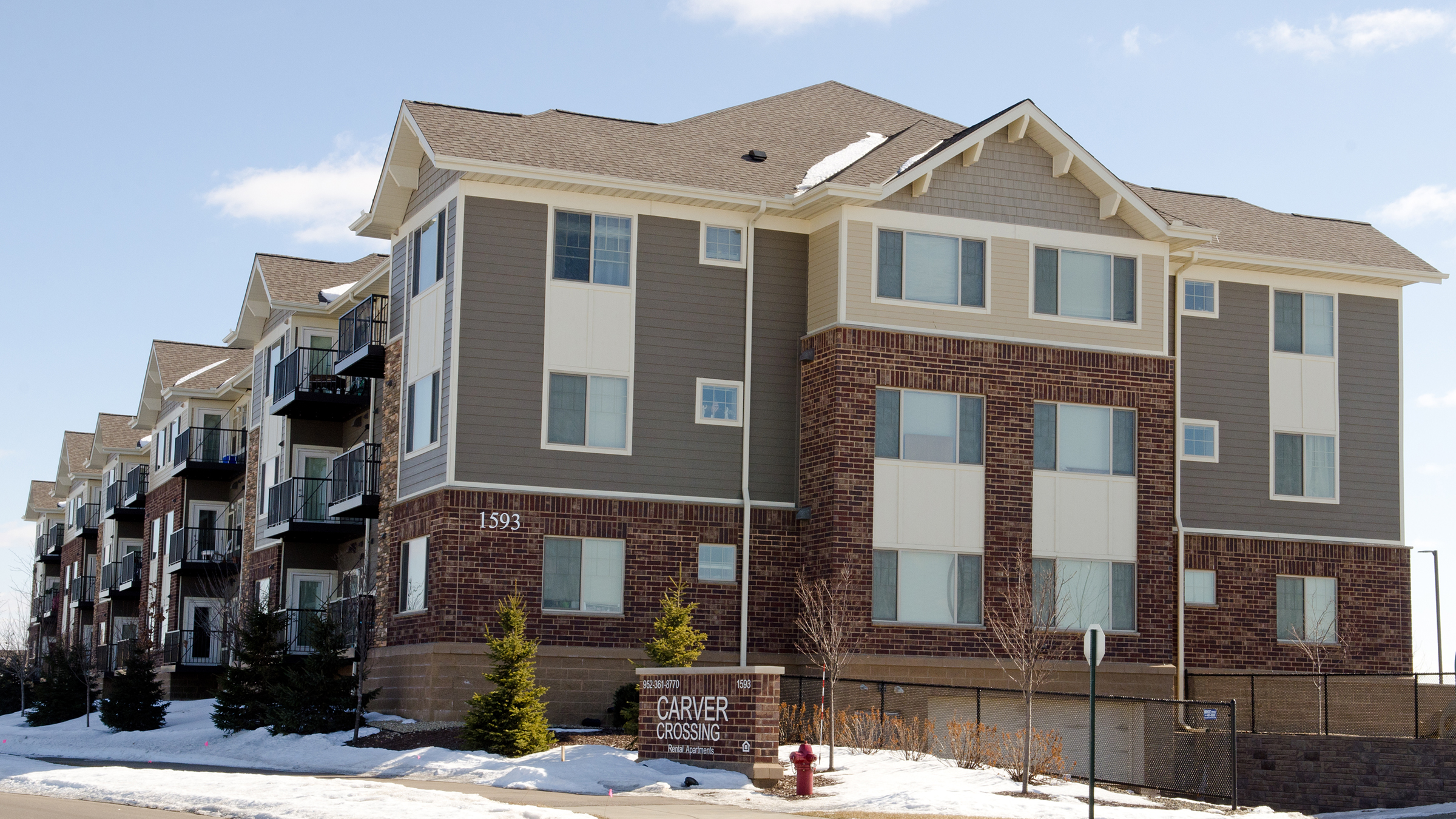In this debut feature in our What works in housing affordability series, we tell the story of Carver Crossing, an income-restricted apartment complex in Carver, Minn., that drew angry opposition from community members during its planning phase. City leaders and the property’s developer moved ahead in ways that ultimately led to community acceptance of the complex and its residents. What mitigated the resistance to Carver Crossing? A few key takeaways:
Take the long view on zoning. For cities facing rapid growth, designating parcels of land for high-density use well ahead of anticipated development can help facilitate future multifamily housing.
Be transparent. Make information about the development process and the project’s financials open to the public; invite community members to view plans and visit comparable, existing developments.
Listen and engage. If opposition arises, hear and acknowledge community members’ concerns, but provide evidence to counter false claims.
A driver turning onto Jonathan Carver Parkway from Highway 212 southwest of Minneapolis is greeted by swaying corn as far as the eye can see on one side of the road and newly built houses stretching to the horizon on the other. The two views offer an easy metaphor for the City of Carver’s past and future: on one side, quiet and agricultural; on the other, rapidly growing.
Farther south, the cornfields give way to a new elementary school and Carver Crossing, a three-story apartment complex whose earth-tone hues, well-kept lawn, and new-growth trees blend in seamlessly with neighboring homes.
The efforts of multiple players made Carver Crossing possible: the City of Carver; the Carver County Community Development Agency (CDA); and Ron Clark Construction, a developer interested in building housing affordable to low- and moderate-income families. Minnesota Housing (the state’s housing finance agency) and the Metropolitan Council (the regional planning authority that serves the seven-county Twin Cities metropolitan area) provided support that made the project’s financing work.
Carver Crossing’s creation included one other crucial ingredient: elected leaders willing to take a stand against a vocal group of community residents who opposed the project. Mike Webb, the former Carver mayor who presided over the project’s final approvals, sees those opponents’ views of “affordable housing” as short-sighted.
“I’d ask the local opponents what brought them to Carver, and they’d say, ‘Oh, it’s a quaint place, it’s a small town,’ and I would laugh. Carver’s a beautiful city with great people, but ultimately, they came here because they got more house for less money,” he said. “That’s called affordable. So why not make Carver affordable for everybody? People should have the opportunity to live here, even if they can’t pay $350,000 for a home because they’re a teacher, or new in their career, or working a lower-wage job.”
Carver’s current mayor, Courtney Johnson, agrees. People obsess over the “affordable” descriptor for Carver Crossing, she says, when in reality, every housing decision is about affordability.
—Mike Webb, Former Mayor, City of Carver
“I live in a house that’s just under $300,000. I don’t live in a house that’s $500,000, because $300,000 was what I could afford,” said Johnson. “That’s universal. It’s only spotlighted because we’re talking about this one project.”
If demand for Carver Crossing is any indication, many more low- to moderate-income households would like to call Carver their home. The waitlist for the complex’s 68 income-restricted units is 900 names long. If it weren’t for the dedication and long-term planning of leaders like Webb and Johnson, even those units wouldn’t exist at all.
A century of stability, then an explosion
Webb, who moved to Carver in 1995, understood why many of his neighbors got emotionally invested in conversations about Carver Crossing. The city had been changing rapidly.
Between the censuses of 1860 and 1990, Carver’s population increased by just 20, growing from 724 to 744. Then, seemingly overnight, Carver drew a surge of interest from home buyers and developers. The city’s population grew by 4,000 people from 1990 to 2018. Most attribute the growth to two large infrastructure investments: changes to Highway 212 that decreased travel time to Minneapolis and the job centers in its inner-ring suburbs, and Carver’s integration into the regional sewer system.
As Carver’s population grew, it also changed. In 1990, the city’s population was 99 percent white. By 2010, the share of white residents had fallen to 88 percent. After adjusting for inflation, the median household income increased from $78,000 in 1990 to $118,000 in 2018. In comparison, the Twin Cities metropolitan area’s median income rose from $70,000 to $76,000 over the same time period. Carver residents are now four times more likely to have a college degree.
“When I first moved here, I was one of the only young, urban professionals,” Webb said. “That just isn’t the case anymore.”
A need to diversify
Carver boasts a downtown district on the National Register of Historic Places. On its main street dotted with dozens of well-maintained brick facades, the city’s small-town past is still easy to imagine. But today, that downtown is an island surrounded by contemporary-looking single-family homes, most less than three decades old.
From 1970 to 1994, the City of Carver issued a total of 94 residential construction permits. From 1995 to 2015, it issued 1,127. All but 40 in those latter two decades were for single-family homes, either detached or townhomes.

The market activity since the 1990s wasn’t supporting the city’s goal to provide a supply of housing for people and families during all phases of their lives, and it wasn’t providing housing opportunities for people of modest means. Former Mayor Webb’s perspective as a small business owner taught him about the need for homes for people at all income levels. Employees at his coffee shop couldn’t afford to live in town, he says.
As single-family construction ramped up, the city and important partners were taking steps to diversify Carver’s housing stock. Those steps included updating the city’s comprehensive plan to submit to the Metropolitan Council. Under state statute, such local comprehensive plans must include a housing implementation program that “will provide sufficient existing and new housing to meet the local unit’s share of the metropolitan area need for low and moderate income housing.”1
At first, Webb recalled, “it felt like the Metropolitan Council was jamming housing down our throats.” He credits the Council’s staff for explaining all the different tools that were available for cities to use to meet their affordable housing requirement. Carver’s city council decided that its best option was to zone a plot of land for high-density development in an appropriate area.
“If we hadn’t done that, I’m not sure we would’ve gotten Carver Crossing off the ground,” said Webb.
Investments and opportunities begin to align
In 2010, the Carver County CDA bought that rezoned plot of land with plans to develop affordable housing on it along with a new city hall for Carver. Those plans sank as the economic fallout from the Great Recession continued. However, the City of Carver added a transit center to the site, making it a more attractive site for a project, said Mike Waldo, the CEO of Ron Clark Construction. By 2013, executives at the company were interested enough to approach the Carver County CDA with a plan.
Ron Clark was a fairly new entrant to building affordable housing. “When the crash hit around 2008, we owned properties in Savage [a Minneapolis suburb located about ten miles east of Carver] intended for retail,” said Waldo. “We could see they were never going to be retail, so we went to the city and asked, ‘What does Savage need?’”
Waldo laughed as he relayed the rest of the conversation. “The city told us they needed affordable housing. We said, ‘What’s that?’”
That project in Savage was a learning experience—and a success. Waldo says that affordable housing has become a part of the company’s overall strategy. Ron Clark gauges a site’s potential for affordable housing on a number of factors, including many that mirror Minnesota’s Qualified Allocation Plan, or QAP. The QAP ranks projects in the competitive allocation process for the state’s block of federal Low Income Housing Tax Credits (LIHTCs),2 an important piece of the financial puzzle for many affordable housing developments.
The company also considers the political situation in a city. If a city council appears hostile to multifamily housing or if an election is close at hand, Waldo says, the risk in a project can increase substantially. As Webb put it, “Elected officials can always find a way to say no,” even if a “no” vote brings on lawsuits and other costs to the city.
City officials are susceptible to public pressure, which is something Ron Clark staff learned the hard way. Waldo recalls a project that initially received unanimous support from a town’s elected officials. Then, a handful of angry residents started to show up at hearings and attack the project online.
“All of a sudden, social media about it just went crazy,” he said. “There was no conversation where people could disagree but reach an understanding. We ended up losing the next two votes, 0 to 5. We lost that project.”
Based on all their metrics, the site for Carver Crossing looked ideal to executives at Ron Clark. To make the project’s finances work, the company sought public investments that would officially apply an income limit to the building’s units. Ultimately, Minnesota Housing awarded the project roughly $10 million worth of LIHTCs and provided partial financing in the form of a low-cost loan.
By 2015, Ron Clark had negotiated a deal with the CDA to develop the first part of the site and was preparing for the city and its planning commission to vote on the plans. Even with his experience facing opposition in other communities, Waldo didn’t expect the intensity of the backlash to come.
Unprecedented pushback
Mayor Johnson was on the city’s planning commission when Ron Clark came forward in 2015. She thought the project would further the long-term housing diversification goals of Carver. But there was also a simpler, more straightforward reason for her vote of approval for Carver Crossing: it met all the requirements laid out in the city’s building codes and planning documents.
So, when she showed up for the planning commission meeting and met a packed house full of angry neighbors, she was surprised. “It was different than anything we’d ever experienced,” Johnson recalled.
—Courtney Johnson, Mayor, City of Carver
Everyone interviewed for this article agreed that some neighbors that night had legitimate concerns. But they also believe that many others were motivated by something baser.
“Almost everybody referred to ‘those people’ moving in,” Johnson said. “That was something we never heard when we were talking about other developments in the city.”
Webb believed that referring to “those people” was a sign that an opponent of the project was making an argument based on racism and ignorance, and he pushed back. “I’d ask them exactly who ‘those people’ were,” he said. Nobody would tell him—except for one neighbor.
“She asked me if I was some kind of ‘n-word-loving liberal,’” he said.
The planning commission approved the project by a margin of 3 to 2. The vocal and sometimes ugly opposition made Ron Clark and the city realize there was a lot they needed to do to answer public questions before the project would come up for a vote at the Carver City Council.
Public tours and open books
Project opponents developed a website and Facebook page. By the time of the city council vote, their arguments had stopped focusing on “those people” and instead focused on crime and property value.
Waldo did his best to counter those arguments with information. For example, when residents alleged that affordable housing would be low-quality, he explained that subsidized projects are generally held to a much higher inspection standard than unsubsidized projects. He also connected Carver’s leaders with public officials in other cities that have Ron Clark projects. Those officials presented data demonstrating that their city had not seen a significant uptick in crime or a decrease in property values or development activity.
Peer officials also gave Carver’s leaders useful pointers, such as recommending that they find a building leasing manager who would be engaged and physically onsite.
Waldo organized public tours of an affordable apartment complex Ron Clark built in Savage, and chartered buses to take any interested parties. The tours demonstrated the high quality of the apartments and humanized the people who lived in them.
—Mike Webb, Former Mayor, City of Carver
According to Webb, the property developer’s track record and transparent practices were just as important as its public engagement. “They were willing to open up their books and explain how everything worked,” Webb said. Ron Clark’s transparency about its bottom line even led the City of Carver to realize it didn’t need to offer tax-increment financing to make the development possible, something it had considered early in the process.
“At the end of the day, these developments happen when people can trust each other,” Webb said.
Listening while sharpening the message
Brent Mareck, Carver’s city manager, did his best to translate information received from the developer for the public and respond promptly and thoroughly to requests for information. The city also paid attention to arguments made in the public debate about the project.
For example, when opponents claimed they had found a study suggesting Carver Crossing would decrease property values, the city hired the same firm to analyze and refute the opponents’ arguments.
In retrospect, Mareck said, the city wasn’t communicating as clearly as it could have before the project—and may have gone too far in the other direction. At one point, a city-maintained website featuring information about the project hosted 65 documents. “Is posting so many links for our residents to try to scroll through the most conducive to learning and understanding?” he questioned.
Mareck thought a lot of the opposition was grounded in a misunderstanding of the development process. “Residents at times believe, ‘If we’re in a democracy, and if enough people don’t want to permit a project, we should be able to stop it,’” said Mareck. “But if someone owns the land, and the city’s codes and comprehensive plan say they are allowed to do something, we can’t just get a bunch of people together and say we don’t want it.”
“A lot of people didn’t understand that we don’t get to decide whether a developer will build luxury apartments or who a developer will be on a given project,” concurred Johnson.
—Courtney Johnson, Mayor, City of Carver
That doesn’t mean the city shouldn’t strive to address their questions, she said. “The pain point for the community was the perception of not being heard. It’s important for the city to show people that just because things didn’t go their way, it doesn’t mean they weren’t heard.”
From “those people” to “our neighbors”
The project’s vocal critics remained, and the city council meeting about the project in March 2015 drew hundreds of attendees, packing the space reserved for it. The Carver City Council approved the project unanimously nonetheless.
Five years later, the controversy is hard to imagine. Single-family homes continue to pop up all around Carver Crossing. A new school sits next to it on Jonathan Carver Parkway. Residents from all over the neighborhood walk to the transit center and use its onsite Express Library. Property values appear strong and, according to city staff, crime rates at Carver Crossing are no different than they are in other neighborhoods.

Mareck and Johnson described a number of ways the city improved its communications practices after Carver Crossing was approved. It now advertises hearings about developments more widely than required by law. It developed user guides for residents who are curious about the city’s practices on everything from zoning to snowplowing. City leaders developed a set of shared values called the Carver Way and hired their first full-time staff member to work on community development issues. City officials are also given more training on leadership and transparency.
“The Carver Way was a stride in the direction of the commissions getting to know each other better,” Mareck said. “To get people to recognize that what’s best for the community isn’t always best for you. We ask potential planning commission members questions like, ‘How would you react to a situation that isn’t good for you, but the ordinance allows it?’”
—Brent Mareck, Manager, City of Carver
The Carver Crossing project wasn’t even an issue when she ran for office less than two years after her planning commission vote, Johnson says. When the Carver County CDA held a meeting about building more multifamily housing near the complex, less than a dozen people dropped by—and none were angry. Carver Crossing gets visits from both Democratic and Republican politicians who lift it up as an example of good practices.
Mareck attributed the shift in attitude to all the work the city’s staff members and officials have done but also one simple ingredient: time.
“It’s just another neighborhood now,” he said. “My daughter is friends with children who live there. Instead of ‘those people’ living at Carver Crossing, it’s John and Tim and Mary and Bill.”
Endnotes
1 Minn. Stat. § 473.859, subd. 4.
2 The federal LIHTC program, established in 1986, provides blocks of federal tax credits that states allocate to developers to help finance affordable housing. For more on LIHTCs, see Novogradac’s Affordable Housing Resource Center.





